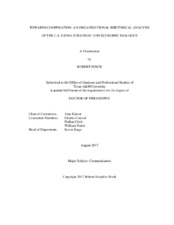| dc.description.abstract | This study analyzes the U.S.-China Strategic and Economic Dialogues (S&ED) to uncover the organizational and rhetorical mechanisms by which U.S. and Chinese officials attempt to forge cooperative relations while managing issues of conflict. I argue for a communication centered approach for understanding geopolitical relations and the socialization process by which norms and values take root amongst U.S. and Chinese officials. To do so, I draw upon organizational institutionalism to uncover competing organizational logics guiding and constraining the S&ED through an organizational rhetorical lens while also providing a new theoretical conception of public diplomacy as a means to legitimize the S&ED as a mechanism for managing the complex bilateral relationship. Texts under analysis include the press releases, speeches, memos of understanding, and agreements published following each of the eight annual S&ED meetings from 2009-2016, totaling over 160 documents.
Findings suggest that the S&ED defines both the dialogue mechanism and bilateral relationship as founded upon a central logic of “positive, cooperative, and comprehensive” relations between the two countries. Resulting from this logic, both the economic and strategic tracks of the S&ED focus on producing ever increasing, tangible outcomes encompassing wider areas of cooperation each year. These outcomes occur most significantly within the economic track discussions as well cooperation on climate change and exchange programs. Not until the later years of the S&ED, with the incorporation of a “new model of major country relations” are more security related issues addressed, with criticism of diverging view points on sensitive issues naturalized as expected given the S&ED’s value of dialogue and attention redirected from these issues to focus on the positive outcomes reached in other areas.
Success of the S&ED relies upon self-reflexive praise by participants of the S&ED regarding its effectiveness in order to justify to domestic constituencies in both nations the continuance and support of the dialogue mechanism. This suggests that even after eight years of meeting, the dialogue mechanism is a fragile one, predicated on producing continuous success. Nonetheless, the breadth and number of agreements, exchanges, and growth of coordination between the bureaucracies of each country demonstrates that cooperation is possible. | en |


